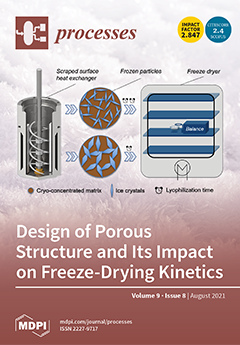A comparative evaluation of alternative methane reforming processes as an option to steam reforming was performed by carrying out simulations of operations in a fixed bed reactor with a Ni (4.8 wt.%/γ-Al
2O
3) catalyst at 1023 K under 1.0 bar.
[...] Read more.
A comparative evaluation of alternative methane reforming processes as an option to steam reforming was performed by carrying out simulations of operations in a fixed bed reactor with a Ni (4.8 wt.%/γ-Al
2O
3) catalyst at 1023 K under 1.0 bar. Methane reforms, including processing with carbon dioxide (DRM, CH
4/CO
2), autothermal reform (ATRM, CH
4/H
2O/O
2), and combined reform (CRM, CH
4/CO
2/H
2O/O
2) had their operations predicted based on experimental data developed to represent their kinetic behavior, formalized with mechanisms and parametric quantifications. The performance of fixed bed reactor operations for methane conversions occurred with different reaction rates in the three alternative processes, and comparatively the orders of magnitude were 10
2, 10
−1, and 10
−4 in CRM, ATRM, and DRM, respectively. According to each process, the methane conversions were oriented towards the predominant productions of hydrogen or carbon monoxide, indicating the kinetic selectivities of H
2, 86.1% and CO, 59.2% in CRM and DRM, respectively. Considering the possibility of catalyst deactivation by carbon deposition, its predicted yields are low due to the slow stages of its production and due to its simultaneous consumption through interactions with O
2, CO
2, and H
2O, reflecting favorably in additional productions of H
2 and CO.
Full article





